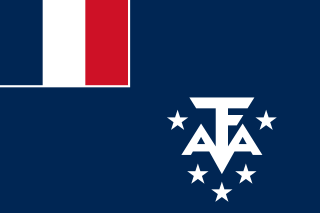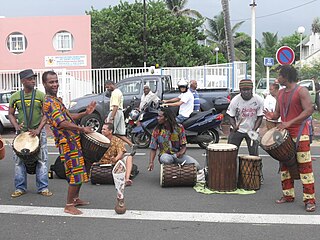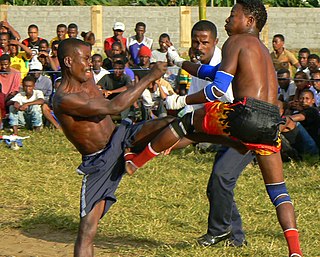Related Research Articles

Madagascar, officially the Republic of Madagascar, is an island country comprising the island of Madagascar and numerous smaller peripheral islands. Lying off the southeastern coast of Africa, it is the world's fourth largest island, the second-largest island country and the 46th largest country in the world. Its capital and largest city is Antananarivo.
The known and sometimes formally documented history of Mauritius begins with its possible discovery by Austronesians under the Austronesian expansion from pre-Han Taiwan, circa 1500 to 1000 BC, and then by Arabs,, followed by Portuguese and its appearance on European maps in the early 16th century. Mauritius was successively colonized by the Netherlands, France and Great Britain, and became independent on 12 March 1968.

Tromelin Island, once called the Isle of Sand, is a low, flat island in the Indian Ocean about 500 km north of Réunion and about 450 km east of Madagascar. Tromelin is part of the Scattered Islands in the Indian Ocean, the fifth district of the French Southern and Antarctic Lands, a French Overseas Territory, but Mauritius claims sovereignty over the island.

The history of Madagascar is distinguished clearly by the early isolation of the landmass from the ancient supercontinent of Pangaea, containing amongst others the African continent and the Indian subcontinent, and by the island's late colonization by human settlers from the Sunda islands and from East Africa. These two factors facilitated the evolution and survival of thousands of endemic plant and animal species, some of which have gone extinct or are currently threatened with extinction. Trade in the Indian Ocean at the time of first colonization of Madagascar was dominated by Indonesian ships, probably of Borobudur ship and K'un-lun po types.

La Réunion, officially Department of La Réunion, is an island in the Indian Ocean that is an overseas department and region of France. Part of the Mascarene Islands, it is located approximately 679 km (422 mi) east of the island of Madagascar and 175 km (109 mi) southwest of the island of Mauritius. As of January 2024, it had a population of 885,700. Its capital and largest city is Saint-Denis.

The Makua people, also known as Makhuwa or Wamakua, are a Bantu ethnic group found in northern Mozambique and the southern border provinces of Tanzania such as the Mtwara Region. They are the largest ethnic group in Mozambique, and primarily concentrated in a large region to the north of the Zambezi River.

The Merina people are the largest ethnic group in Madagascar. They are the "highlander" Malagasy ethnic group of the African island and one of the country's eighteen official ethnic groups. Their origins are mixed, predominantly with Austronesians arriving before the 5th century AD, then many centuries later with mostly Bantu Africans, but also some other ethnic groups. They speak the Merina dialect of the official Malagasy language of Madagascar.

Sega is one of the major music genres of Mauritius and Réunion. It is a complete performance art, involving music, story-telling and traditional dance. Musically, the most modern forms common in Mauritius are its fusion genre Seggae and bhojpuri variations, whilst in Réunion we find the addition of maloya, the latter being much closer to the older, typical music influences originating from Madagascar. The variety of different sega forms is reflected in the multi-ethnic populous of the indigenous population of Mauritius.

The Malagasy are a group of Austronesian-speaking ethnic groups indigenous to the island country of Madagascar. Traditionally, the population have been divided into ethnic groups. Examples include "Highlander" groups such as the Merina and Betsileo of the central highlands around Antananarivo, Alaotra (Ambatondrazaka) and Fianarantsoa, and the "coastal dwellers" such as the Sakalava, Bara, Vezo, Betsimisaraka, Mahafaly, etc.

The Sakalava are an ethnic group of Madagascar. They are found on the western and northwest region of the island, in a band along the coast. The Sakalava are one of the smallest ethnic groups, constituting about 6.2 percent of the total population, that is about 2,079,000 in 2018. Their name means "people of the long valleys." They occupy the western edge of the island from Toliara in the south to the Sambirano River in the north.

Maloya is one of the two major music genres of Réunion, usually sung in Réunion Creole, and traditionally accompanied by percussion and a musical bow. Maloya is a new form that has origins in the music of African and Malagasy slaves and Indian indentured workers on the island, as has the other folk music of Réunion, séga. World music journalists and non-specialist scholars sometimes compare maloya to the American music, the blues, though they have little in common. Maloya was considered such a threat to the French state that it was banned in the 1970s.

The culture of Madagascar reflects the origins of the Malagasy people in Southeast Asia, East Africa and Oceania. The influence of Arabs, Indians, British, French and Chinese settlers is also evident.

Andriana was both the noble class and a title of nobility in Madagascar. Historically, many Malagasy ethnic groups lived in highly stratified caste-based social orders in which the Andriana were the highest strata. They were above the Hova and Andevo (slaves). The Andriana and the Hova were a part of Fotsy, while the Andevo were Mainty in local terminology.

The KingdomofMerina, or Kingdom of Madagascar, officially the Kingdom of Imerina, was a pre-colonial state off the coast of Southeast Africa that, by the 18th century, dominated most of what is now Madagascar. It spread outward from Imerina, the Central Highlands region primarily inhabited by the Merina ethnic group with a spiritual capital at Ambohimanga and a political capital 24 km (15 mi) west at Antananarivo, currently the seat of government for the modern state of Madagascar. The Merina kings and queens who ruled over greater Madagascar in the 19th century were the descendants of a long line of hereditary Merina royalty originating with Andriamanelo, who is traditionally credited with founding Imerina in 1540.

The Makoa are an ethnic group in Madagascar descended from enslaved people from mainland Africa that were traded through the major slave trading ports of northern Mozambique in an area mainly populated by the Makua people. They are among the last African diaspora communities in the world to issue from the slave trade. They are sometimes classified as a subgroup of the fishing peoples known as the Vezo, although the Makoa maintain a distinct identity, one reinforced by their larger physical stature and historic employment as police officers by the French colonial administration.
Literature of Réunion is the literature of persons linked to the island of Réunion, a French overseas department in the Indian Ocean east of Madagascar. It is written in French and in Réunionnais creole as well as other languages.

Moraingy is an unarmed, bare-fisted striking style of traditional martial art from Madagascar.

Accounts of Jews in Madagascar go back to the earliest ethnographic descriptions of the island, from the mid-17th century. Madagascar has a small Jewish population, including normative adherents as well as Judaic mystics, but the island has not historically been a significant center for Jewish settlement. Despite this, an enduring origin myth across Malagasy ethnic groups suggests that the island's inhabitants descended from ancient Jews, and thus that the modern Malagasy and Jewish peoples share a racial affinity. This belief, termed the "Malagasy secret", is so widespread that some Malagasy refer to the island's people as the Diaspora Jiosy Gasy. As a result, Jewish symbols, paraphernalia, and teachings have been integrated into the syncretic religious practices of some Malagasy populations. Similar notions of Madagascar's supposed Israelite roots persisted in European chronicles of the island until the early 20th century, and may have influenced a Nazi plan to relocate Europe's Jews to Madagascar. More recently, the possibility of Portuguese Jewish conversos making contact with Madagascar in the 15th century has been proposed.

Mauritian Creole or Morisien is a French-based creole language spoken in Mauritius. English words are included in the standardized version of the language. In addition, the slaves and indentured servants from cultures in Africa and Asia left a diverse legacy of language in the country. The words spoken by these groups are also incorporated into contemporary Morisien.

The Andevo, or slaves, were one of the three principal historical castes among the Merina people of Madagascar, alongside the social strata called the Andriana (nobles) and Hova. The Andevo, along with the other social strata, have also historically existed in other large Malagasy ethnic groups such as the Betsileo people.
References
- 1 2 3 Medea, Laurent (2002). "Creolisation and Globalisation in a Neo-Colonial Context: the Case of Réunion". Social Identities. 8 (1): 125–141. doi:10.1080/13504630220132053. S2CID 145370724.
- 1 2 Yu-Sion, Live (July–August 2003), "Illusion identitaire et métissage culturel chez les "Sinoi" de la Réunion", Perspectives Chinoises, 2003 (78), ISSN 1021-9013 , retrieved 2008-11-01
- ↑ Mayoka, Paul (1997). L'image du Cafre. Saint-Denis: Publications Hibiscus. pp. 12–13. ISBN 978-2-912266-00-2.
- ↑ see also: the article CAFRE, cafrine Archived 2009-12-14 at the Wayback Machine of the lexicon which appears in Beniamino, Michel (1996). Le français de La Réunion. Vanves: EDICEF. ISBN 978-2-84129-240-0. Archived from the original on 2009-07-09.
- ↑ "Nourritures" (PDF). Archived from the original (PDF) on 2012-03-08. Retrieved 2016-10-03.
- ↑ Esther, Martine. Les Damnés des tropiques. Editions Publibook. p. 105. ISBN 978-2-7483-4222-2 . Retrieved 2009-12-18.